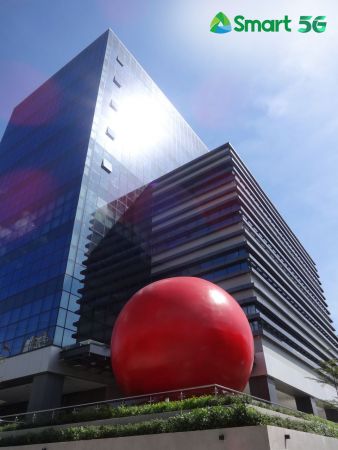
Live TV coverage powered by 5G?
PLDT and its wireless subsidiary Smart Communications, Inc. (Smart) have taken a step closer to that goal by recently firing up Smart 5G at the TV5 Media Center in Mandaluyong City.
The Smart 5G facilities were launched in time for PLDT Enterprise’s “Keep Moving Forward” event last August 4, where they unveiled their expanded roster of wireless services and solutions for Enterprise customers, including the first commercial mobile enterprise 5G plans in the country.
With 5G available in its studios, TV5’s production teams, news anchors and reporters can now start exploring how to use Smart 5G-certified devices for their live coverage and news gathering activities.
“This is part of our commitment to make the latest technologies, innovations and solutions available to our customers,” said Alfredo S. Panlilio, Smart President and CEO and PLDT Chief Revenue Officer.
“Recently, we made Smart 5G commercially available so that our subscribers can try it out and enjoy its super-fast data service. With Smart 5G now up at the TV5 studios, we look forward to working more closely and co-innovating with TV5 to find out how we can further harness 5G together to modernize their news operations,” he added.

5G for innovation
PLDT chief technology and information advisor Joachim Horn, speaking during the PLDT Enterprise virtual event, highlighted 5G’s flexibility as a key feature that enhances its value.
“LTE is a one-size-fits-all network. You have one network and you can do many things with it. But because it is one-size-fits-all, it is not very flexible. That’s the difference with 5G,” he said. “5G is much more flexible. It is highly customizable, and that makes it particularly interesting for Enterprise customers.”
Horn cited sample use cases that can analyze crowd and traffic flows using cameras. “This capability has become very relevant in the time of social distancing, to be able to—without physical contact or human interaction—to steer through crowds, avoid crowd build-up, or manage the traffic flow,” he said.
Horn also highlighted how Smart’s 5G was used during the Southeast Asian Games as another relevant use case. “5G livestreaming and augmented reality with high quality videos can enable completely new experiences. You could watch sports as if you were there, without having to be there. Especially in these times, these are very important innovations made possible by 5G.”
“5G is a platform for you to innovate new solutions. It provides you the flexibility to innovate your business with the solution you need in order to cope with the situation we are in,” Horn said.
Leader in 5G
The strategy to deploy 5G has been embedded in Smart’s network planning over the past five years. PLDT’s wireless subsidiary started conducting tests with 5G in 2016. In 2018, it fired up the country’s first 5G base stations in Makati with Huawei and the Clark Freeport Zone in Pampanga with Ericsson. Last year, Smart also launched the first Smart 5G Lifestyle hub and 5G-enabled shopping mall In Araneta City, as well as the first Smart 5G campus at the Ateneo de Manila University.
Smart’s 5G mobile network also recently went live as a commercial service. In this initial phase of its commercial deployment, Smart Signature, Infinity and other Smart postpaid subscribers will be able to enjoy the super-fast data service of Smart 5G in key business districts of Metro Manila using Smart-certified handsets with 5G-activated SIMs.
These areas include the Makati Central Business District (CBD), Bonifacio Global City CBD, Araneta City, SM Megamall and Mall of Asia Bay Area. Smart 5G is also being rolled out in key high-traffic areas such North Avenue in Quezon City and Taft Avenue in Manila, as well as in Ortigas CBD, and Clark Green City in Pampanga.
Steady investment effort
The 5G deployment plan involved a steady investment effort by PLDT and Smart that has amounted to nearly P260 billion in overall capital expenditure (capex) spend over the past five years. In 2019 alone, the PLDT Group’s capex reached a record Php72.9 billion. Moreover, 2020 capex is expected to reach Php70 billion despite the slowdown in network rollout due to the quarantine controls imposed in the second quarter of this year.
This capex program enabled PLDT and Smart to build the digital infrastructure needed to support the deployment first of 4G/LTE and later 5G. This involved the deployment of an extensive optic fiber network. The PLDT Group’s fiber network is the most pervasive in the country and extends to over nearly 360,000 kilometers as of June 2020.
With this extensive fiber network, Smart has been able to fast-track the nationwide roll out of its 4G/LTE service that when combined with its 3G service now provides high-speed mobile internet service to over 93% of the country’s cities and municipalities and 95% of the population. Moreover, in its ongoing LTE and LTE-Advanced roll-out, Smart has been installing 5G-capable equipment which will enable Smart to deploy 5G easier and faster.

